| ________________
CM . . . . Volume XVII Number 22. . . .February 11, 2011. 
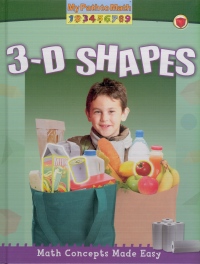 |
3-D Shapes. (My Path to Math).
Marina Cohen.
St. Catharines, ON: Crabtree, 2011.
24 pp., pbk. & hc., $7.95 (pbk.), $18.36 (RLB.).
ISBN 978-0-7787-6788-6 (pbk.),
ISBN 978-0-7787-6779-4 (RLB.).
Subject Heading:
Shapes-Juvenile literature.
Kindergarten-grade 4 / Ages 5-9.
Review by Thomas Falkenberg.
*** /4
|
| |
|
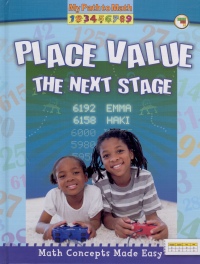 |
Place Value: The Next Stage. (My Path to Math).
Claire Piddock.
St. Catharines, ON: Crabtree, 2011.
24 pp., pbk. & hc., $7.95 (pbk.), $18.36 (RLB.).
ISBN 978-0-7787-6792-3 (pbk.),
ISBN 978-0-7787-6783-1 (RLB.).
Subject Headings:
Place value (Mathematics)-Juvenile literature.
Counting-Juvenile literature.
Numeration-Juvenile literature.
Grades 1-4 / Ages 6-9.
Review by Thomas Falkenberg.
*** /4
|
| |
|
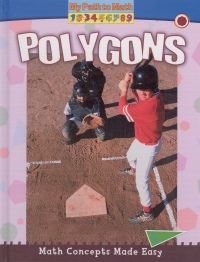 |
Polygons. (My Path to Math).
Marina Cohen.
St. Catharines, ON: Crabtree, 2011.
24 pp., pbk. & hc., $7.95 (pbk.), $18.36 (RLB.).
ISBN 978-0-7787-6793-0 (pbk.),
ISBN 978-0-7787-6784-8 (RLB.).
Subject Heading:
Polygons-Juvenile literature.
Grades 2-4 / Ages 7-9.
Review by Thomas Falkenberg.
*** /4
|
| |
|
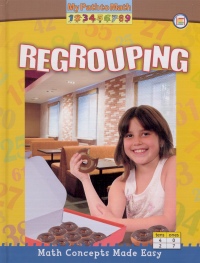 |
Regrouping. (My Path to Math).
Claire Piddock.
St. Catharines, ON: Crabtree, 2011.
24 pp., pbk. & hc., $7.95 (pbk.), $18.36 (RLB.).
ISBN 978-0-7787-6794-7 (pbk.),
ISBN 978-0-7787-6785-5 (RLB.).
Subject Headings:
Addition-Juvenile literature.
Subtraction-Juvenile literature.
Grades 2-4 / Ages 7-9.
Review by Thomas Falkenberg.
*** /4
|
| |
|
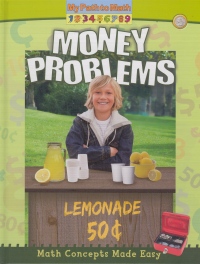 |
Money Problems. (My Path to Math).
Marina Cohen.
St. Catharines, ON: Crabtree, 2011.
24 pp., pbk. & hc., $7.95 (pbk.), $18.36 (RLB.).
ISBN 978-0-7787-6791-6 (pbk.),
ISBN 978-0-7787-6782-4 (RLB.).
Subject Headings:
Counting-Juvenile literature.
Money-Juvenile literature.
Grades 3-5 / Ages 8-10.
Review by Thomas Falkenberg.
** /4
|
| |
|
 |
Area. (My Path to Math).
Marsha Arvoy & Dorianne Nardi.
St. Catharines, ON: Crabtree, 2011.
24 pp., pbk. & hc., $7.95 (pbk.), $18.36 (RLB.).
ISBN 978-0-7787-6789-3 (pbk.),
ISBN 978-0-7787-6780-0 (RLB.).
Subject Heading:
Area measurement-Juvenile literature.
Grades 3-5 / Ages 8-10.
Review by Thomas Falkenberg.
** /4
|
| |
|
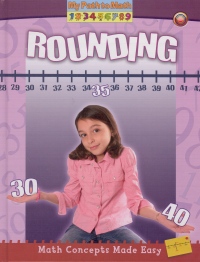 |
Rounding. (My Path to Math).
Marsha Arvoy & Dorianne Nardi.
St. Catharines, ON: Crabtree, 2011.
24 pp., pbk. & hc., $7.95 (pbk.), $18.36 (RLB.).
ISBN 978-0-7787-6795-4 (pbk.),
ISBN 978-0-7787-6786-2 (RLB.).
Subject Heading:
Rounding (Numerical analysis)-Juvenile literature.
Grades 3-5 / Ages 8-10.
Review by Thomas Falkenberg.
* /4
|
| |
|
|
|
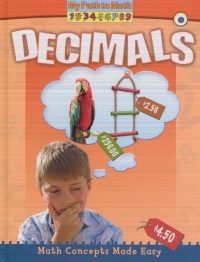 |
Decimals. (My Path to Math).
Claire Piddock.
St. Catharines, ON: Crabtree, 2011.
24 pp., pbk. & hc., $7.95 (pbk.), $18.36 (RLB.).
ISBN 978-0-7787-6790-9 (pbk.),
ISBN 978-0-7787-6781-7 (RLB.).
Subject Heading:
Decimal fractions-Juvenile literature.
Grades 4-6 / Ages 9-11.
Review by Thomas Falkenberg.
*** /4
|
| |
|

excerpt:
Dad explains that the names for polygons have to do with how many sides they have. Tri means "three." A triangle has three sides.
All polygons have at least three sides. All polygons have at least three vertices, too. A vertex is like a corner. They are the points where two sides of a polygon meet. (From Polygons.)
The eight books reviewed here are from the series "My Path to Math" by Crabtree Publishing, which, up to now, has grown to a set of 32 books. The series is designed for primary grade students and teachers. Each of the volumes has 24 pages. Each double-page in a volume addresses one particular aspect of the mathematical concept and idea the whole volume deals with. The text is printed in larger font (appropriate for primary school children), and there are many coloured pictures and images used that often provide a pictorial representation of the respective mathematical concepts and ideas. Each volume has an index page at the end as well as a double-page glossary in which the central terms used in the respective volume are explained in one sentence.
All the volumes reviewed here are written to help students with developing conceptual understanding of mathematical concepts and ideas. Practising procedural fluency is not part of any of the books. In most cases, the reviewed volumes do a very good job in extracting the central ideas of each concept a volume deals with and provide some meaningful activities for students to engage in (mentally and sometimes physically) to help the reader with the respective concept. Understandable, representing the network of ideas behind a concept like area on 21 large-print pages with pictures is not an easy undertaking.
While the basis upon which each volume deals with a particular mathematical concept and idea is sound in terms of what teachers should consider in their teaching of mathematics, the volumes are, in my view, of only limited value as books for students to learn from by reading them on their own. This has to do with what the publisher seems not to acknowledge. The book series has a motto that is printed at the bottom of each cover: "Math Concepts Made Simple". Mathematical concepts and ideas are complex and abstract, and they cannot be made simple. Understanding mathematical concepts and ideas requires engagement with those concepts and ideas in meaningful and various ways. Mathematics education research would strongly suggest that the different aspects of mathematical concepts, like place value, decimals, rounding, and so on, cannot be learned by students reading a double page. It requires engagement with a number of different tasks, generally facilitated by a teacher; and it is as a teacher's resource to engage students in thinking about mathematical ideas that I see being the primary value of the book series. Supplemented with other materials and activities, the volumes provide teachers with a number of mental and physical activities and visual representations that they can use to engage students with the respective mathematical ideas and concepts in a meaningful way.
There is a major issue with the series from a Canadian perspective: the series seems clearly be designed for the American rather than the Canadian market. While this is understandable from a marketing perspective, it is problematic from a perspective of Canadian school education. This US focus has two problematic implications for the use of the series in a Canadian context. The first is linked to references to US money and the Imperial measurement system that is dominantly used in the US. Whenever the series uses images of money (as in the books on rounding, on decimals, and on money problems), it is American money that is illustrated. Similarly, in the book on area, predominantly the Imperial unit system (inches, square inches, etc.) rather than the metric unit system (centimeter, square centimeters, etc.) is used. Second, the books in the series show images of Caucasian and Afro-American children and adults, but there are no images of students, teachers, or parents that reflect the multi-ethnic backgrounds of Canadians, and, in particular, there are not images of Aboriginal students or parents in any of the books.
Some of the reviewed books have received lower recommendation ratings than other books in the series. Those books that used illustrations of American money received a lower rating. There are some conceptual problems in the book on area. First, page 5 shows a square formed by 12 times 12 square units; however, the unit squares are not side by side, which is conceptually problematic, since linking units end to end is an important feature of properly measuring. Second, on page 16, the idea of estimating area is introduced through the example of measuring the area of a foot print using grid paper. While the image on page 17 shows on grid paper the outline of a non-rectangular foot (a general feature of a human foot!), the text on page 16 says that "they find that the area of her foot is 24 square inches." However, it is very unlikely that the foot print has exactly a whole number area in square inches, and even if it had, it would require the adding of fractions of square units because of the shape of the human foot – as also suggested by the image on page 17. Neither is this problem addressed in the section, nor is the idea of estimating the area of a non-rectangular shape like a human foot using a grid introduced. Third, on page 12, "Jeffrey measures the area of his block", but it is not clear, neither from the text nor from the image on p. 13, what the two authors mean by "area of a block" – is it the "surface area" or the "area of one face of the block"? Also, the relations of the square units and the blocks in the picture on p. 13 also do not seem to match the relations given in the text. .
The lowest rating was given to the book on rounding, because this book, compared to the others, does not seem to help students understand central features of the respective concept (here, rounding). At the centre of the book is the use of "the rounding rule" (p. 6), but nowhere is it made sufficiently clear why this rule exist in the first place. In addition, the "rounding rule" is not generally applicable, which is not addressed in the book either. For instance, if I want to know whether I can afford to buy three items of a particular price, I would need to round up each of the princes in each of the three cases, which can contradict "the rounding rule." To understand the central idea of rounding, students need to understand that rounding is a replacement strategy of one number by another number based on what I want this strategy to accomplish. If, for instance, I want an estimated sum of three numbers, I need to get to the closest larger number (relative to the required place value) for each of the three numbers, which leads to rounding up in some cases and to rounding down in other cases. Here "the rounding rule" is to be used. But, if I want to know whether the total of the three numbers does not exceed a certain number, I will need to round up each of the three numbers. Here, "the rounding rule" is not to be used.
Recommended with reservations.
Thomas Falkenberg is a teacher educator in the Faculty of Education at the University of Manitoba in Winnipeg, MB.

To comment on this title or this review, send mail to
cm@umanitoba.ca.
Copyright © the Manitoba Library Association. Reproduction for personal use is permitted only if this copyright notice is maintained. Any other reproduction is prohibited without permission.
NEXT REVIEW |
TABLE OF CONTENTS FOR THIS ISSUE- February 11, 2011.
AUTHORS |
TITLES |
MEDIA REVIEWS |
PROFILES |
BACK ISSUES |
SEARCH |
CMARCHIVE |
HOME |







